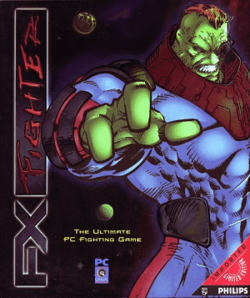FX Fighter
| FX Fighter | |
|---|---|
 | |
| Developer(s) | Argonaut Games |
| Publisher(s) | GTE Entertainment |
| Engine | BRender[1] |
| Platform(s) | MS-DOS |
| Release |
(FX Fighter) June 24, 1995 (FX Fighter Turbo) November 5, 1996 |
| Genre(s) | Fighting game |
| Mode(s) | Single player, multiplayer |
FX Fighter is a video game developed by Argonaut Games and released by GTE Entertainment in 1995. It was an early realtime 3D fighting game to be developed for the PC. The game was also being developed for the Super Nintendo Entertainment System, but eventually only the PC CD-ROM version for MS-DOS was released.
The game features 8 different characters, 8 different arenas, movie cut scenes, and 40 attacks per fighter. The player selects a character to face against 8 of the best fighters in the universe, with the prize being the most powerful weapon in the universe.
Versions
3D acceleration
OEM versions of this title have support for 3D acceleration. These were bundled with 3D graphics accelerator cards of the time, such as the Diamond Monster 3D.[2]
Super NES
A version for the Super Nintendo Entertainment System was previewed in GamePro[3] and Nintendo Power[4] and relies on the Super FX powered GSU-2 (or "Super FX 2") chip to deliver polygon graphics that were otherwise unattainable on the SNES. At the Winter 1995 Consumer Electronics Show, GTE Entertainment and Nintendo announced that they would be jointly developing and publishing the game.[5][6] However, after Nintendo decided to port Killer Instinct to the SNES, the SNES version of FX Fighter was canceled to avoid competition between the two games.[7]
Reception
For the launch of FX Fighter, GTE Entertainment shipped 200,000 units of the game to stores and dedicated in excess of $2 million to its promotional campaign.[8]
Entertainment Weekly gave the game an A- and wrote that "Just in time for the arrival of the latest batch of super-realistic (read: incredibly violent) fighting games from the likes of Sega and Sony comes FX Fighters, a pumped-up PC effort, which proves that, when programmers put their minds to it, a 486 or Pentium computer can go pixel for pixel against the Saturn or 3DO. But I'm not sure that it's more enjoyable to knock the snot out of an alien street brawler on a computer than to do it on a TV screen — there's something about the living-room tube that lends itself more easily to this type of mindless but enjoyable mayhem."[9]
Next Generation reviewed the PC version of the game, rating it four stars out of five, and stated that "Even without the spectacular visuals, FX Fighter would be better than Mortal Kombat II - and that's saying a lot."[10]
Sequel
FX Fighter Turbo is a sequel that was released for the PC in 1996 with new characters, moves, environments, costumes, special effects, network play, and support for Microsoft Windows and the S3 Graphics chipset. As did many other fighting games at the time, FX Fighter Turbo followed suit with Mortal Kombat by including fatalities, a feature not seen in the previous game.
See also
References
- ↑ "3D Realms". Next Generation. Imagine Media (10): 99. October 1995.
- ↑ "Diamond Announces Retail Monster 3D Gaming Accelerator Bundled with 10 Hot Titles This Halloween". Business Wire. October 31, 1996. Archived from the original on July 14, 2006.
- ↑ "FX Fighter". GamePro. IDG (76): 195. January 1995.
- ↑ "Nintendo Power". Nintendo Power. Nintendo (69).
- ↑ "GTE and Nintendo Enter into FX Fighter Partnership Agreement". Electronic Gaming Monthly. No. 68. Sendai Publishing. March 1995. p. 57.
- ↑ Bateman, Selby (April 1995). "Movers & Shakers". Next Generation. No. 4. Imagine Media. p. 27.
- ↑ "GTE Interactive Takes FX Fighter to the PC". Electronic Gaming Monthly. No. 73. Sendai Publishing. August 1995. p. 28.
- ↑ "FX FIGHTER PULLS EARLY RETAILER DEMAND WITH INITIAL CHANNEL SELL-IN OF 200,000 UNITS; SHIPMENT UNDERWAY TO 18,000 RETAIL OUTLETS" (Press release). Archived from the original on June 7, 1997. Retrieved September 11, 2018.
- ↑ "FX Fighter". Retrieved September 14, 2018.
- ↑ "Finals". Next Generation. No. 9. Imagine Media. September 1995. p. 97.